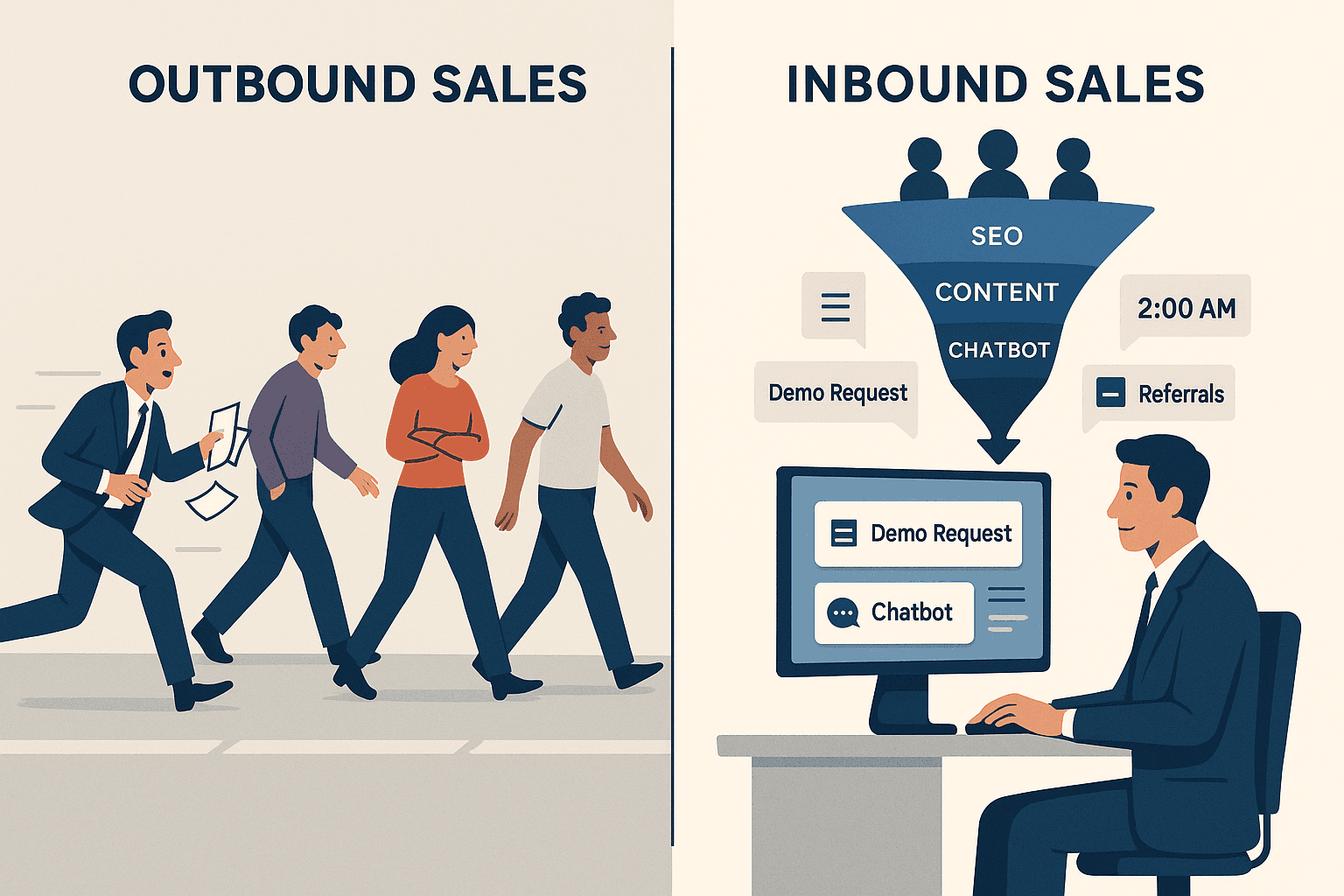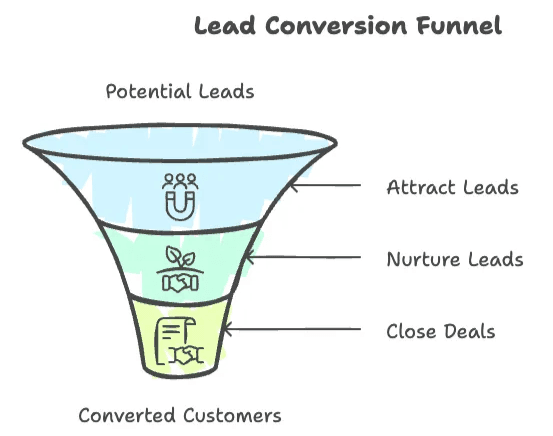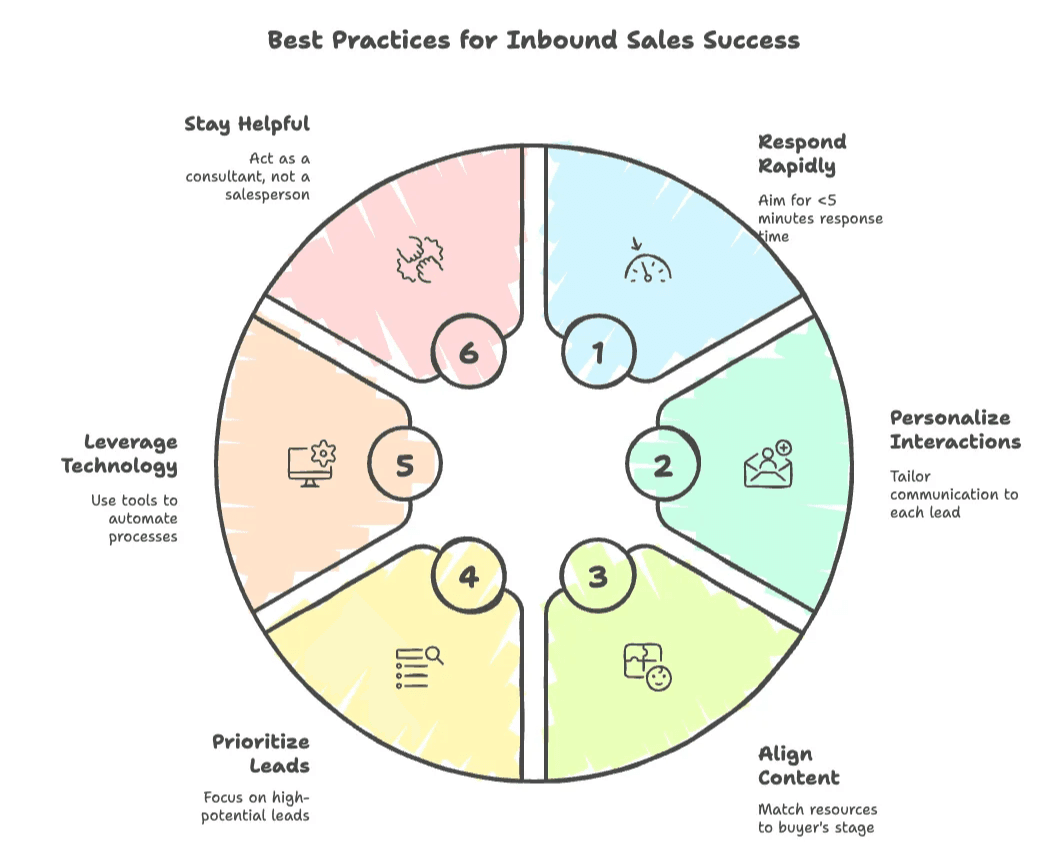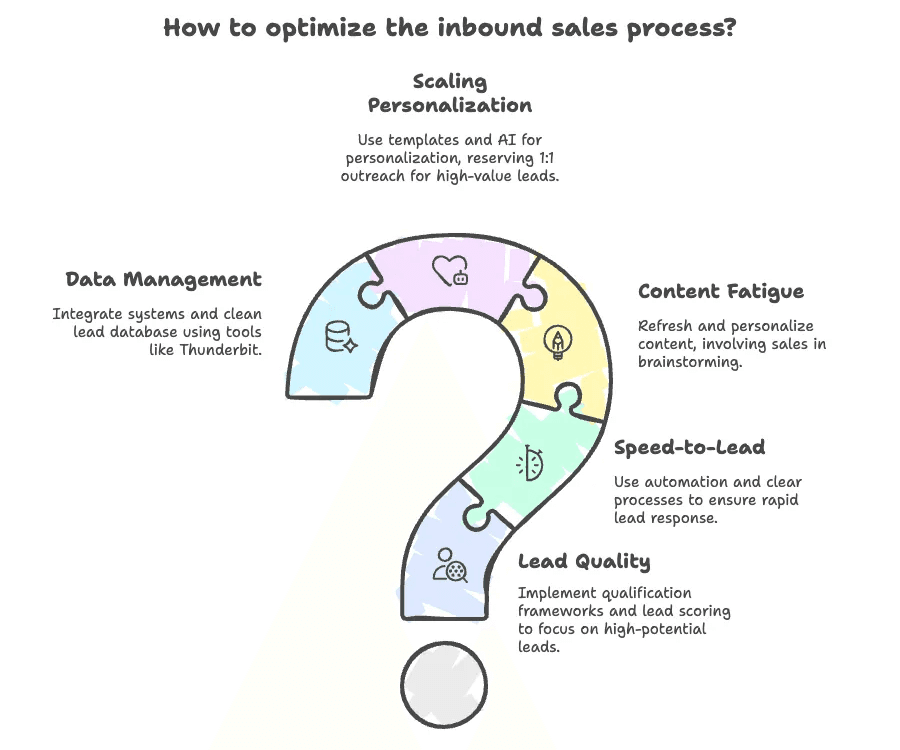I’ll never forget the first time I realized just how much the sales world had changed. It was a Tuesday—because, let’s be honest, all big revelations happen on a Tuesday—when a friend in SaaS sales called me, frustrated. “Shuai, I just spent my whole morning cold-calling, and all I got was a voicemail maze and a couple of polite rejections. Meanwhile, my teammate closed two deals just by following up with people who’d downloaded our eBook last week. What gives?”
That’s when it hit me: the rules of lead generation have flipped. In today’s digital-first world, inbound sales isn’t just a buzzword—it’s the engine behind the highest-quality leads and the most efficient sales teams. With customer acquisition costs climbing and buyers dodging cold calls like they’re in the Matrix, sales and operations teams are hungry for a better way. So, let’s dive into what inbound sales really means, how it stacks up against outbound sales, and how tools like can help you turn digital interest into real revenue—without losing your sanity (or your voice).
Inbound Sales Explained: What Does It Really Mean for Lead Generation?
Let’s cut through the jargon. Inbound sales is all about meeting buyers where they are—when they’re already interested, already searching, and already halfway down the funnel before you even say “hello.” Instead of chasing down strangers, inbound sales teams focus on attracting prospects who raise their hands first. These are the folks who fill out your demo request, download your whitepaper, or ping your chatbot at 2 a.m. because they’re ready to solve a problem.
But here’s where it gets interesting: inbound sales isn’t the same as inbound marketing, even though they’re often mentioned in the same breath. Inbound marketing is about creating content and campaigns that pull people in—think blog posts, SEO, webinars, and social media. Inbound sales picks up the baton once those leads come in, guiding them through the buying process with personalized outreach and tailored solutions (). So, while marketing gets the party started, sales makes sure the right guests get the VIP treatment.
Why does this distinction matter? Because if you’re in sales or operations, knowing where marketing ends and sales begins helps you focus your energy. Marketing brings in the crowd; sales turns the crowd into customers. Both are essential, but the handoff is where the magic (okay, not using that word—let’s say “results”) happens.
Inbound Sales vs. Outbound Sales: Key Differences Every Team Should Know
If inbound sales is about “pull,” outbound sales is pure “push.” Outbound sales means you’re reaching out cold—think unsolicited emails, cold calls, or knocking on doors (literal or digital). Inbound sales, on the other hand, is all about responding to people who’ve already shown interest ().
Let’s break it down with some real-world flavor:
- Outbound Sales: You buy a list, dial for dollars, and hope someone bites. You’re the party crasher.
- Inbound Sales: Someone fills out your “Request a Demo” form. You’re the host, welcoming guests who actually want to be there.

And the numbers back it up. Inbound tactics generate than outbound, and at a . Meanwhile, outbound-generated leads cost . Ouch.
Comparing Inbound and Outbound Sales for Lead Generation
Here’s a quick side-by-side to make it crystal clear:
| Aspect | Inbound Sales | Outbound Sales |
|---|---|---|
| Lead Origin | Prospects find you (content, SEO, referrals) | You find prospects (cold calls, emails) |
| Lead Quality | Warmer, self-qualified, higher intent | Colder, less qualified, lower intent |
| Cost per Lead | Lower (62% less) | Higher (39% more) |
| Conversion Rate | ~14–15% (Responsify) | ~1–2% |
| Customer Experience | Buyer-initiated, consultative, trust-building | Seller-initiated, often intrusive |
| Sales Cycle | Shorter, smoother | Longer, more touches required |
The takeaway? Inbound sales is like fishing with bait the fish actually want, while outbound is casting a net and hoping for the best.
Why Inbound Sales Matters: The Business Value for Sales and Operations Teams
So, why should sales and ops teams care about inbound sales? Because it’s a direct line to higher ROI, better lead quality, and happier customers. Let’s get specific:
- Higher ROI: Content-driven inbound marketing produces and saves .
- Better Conversion: Inbound leads convert at , compared to just 1–2% for outbound.
- Lower CAC: Companies see a when they focus on inbound.
- Higher-Quality Leads: say inbound sources yield better leads.
- Sales-Marketing Alignment: Inbound sales forces teams to work together, closing the classic “the leads are junk” vs. “sales can’t close” blame game.
Use Cases: Inbound Sales in Action
Here are some classic inbound sales scenarios—and why they work:
| Scenario | Inbound Advantage |
|---|---|
| Demo/Trial Requests | Responding within 5 minutes makes you 21× more likely to qualify the lead |
| Content Downloads | Personalized follow-up based on what they downloaded (“I saw you grabbed our supply chain guide…”) |
| Referral Leads | Built-in trust and higher close rates |
| Website Inquiries | 78% of B2B buyers purchase from the first vendor to respond (Chili Piper) |
| Social Media Engagement | Engaging prospects where they’re already active, building credibility before the sales pitch |
The common thread? Inbound sales turns interest into opportunity, fast.
The Inbound Sales Process: From Lead Generation to Closing Deals
Let’s walk through the inbound sales journey—from that first spark of interest to the final handshake (or DocuSign click).

Attracting Leads: Content, SEO, and Digital Touchpoints
Attracting inbound leads is a team sport. Marketing lays the groundwork with blogs, SEO, and webinars, but sales can play too—think LinkedIn posts, webinars, or even answering questions in industry forums. Companies with 30+ landing pages generate than those with just a handful.
Some practical tips:
- Align content with buyer pain points. If your prospects keep asking about a challenge, write about it.
- Use clear calls to action. Every blog, webinar, or landing page should invite the next step (“Download the guide,” “Book a demo”).
- Leverage social media. .
Nurturing and Qualifying Inbound Leads
Once a lead comes in, speed and personalization are everything. Responding within 5 minutes makes you , but the average B2B response time is a whopping 42 hours. Yikes.
Best practices:
- Respond fast, but not generic. Reference what drew them in (“Saw you attended our webinar on data security…”).
- Qualify gently. Use frameworks like BANT (Budget, Authority, Need, Timeline) to prioritize leads.
- Nurture over time. Not every lead is ready to buy now—. Stay on their radar with helpful content and check-ins.
Closing: Turning Inbound Leads into Customers
When it’s time to close, inbound sales is about trust, not pressure. The prospect already knows your brand—they just need reassurance.
- Be consultative. Focus on solving their problem, not just selling your product.
- Address objections honestly. If they’re worried about support, share customer stories or data.
- Create gentle urgency. Tie timelines or incentives to their goals (“If you want to launch by Q4, let’s get started this month…”).
- Follow through post-sale. Onboarding and support matter—a happy customer today is a referral tomorrow.
Best Practices for Inbound Sales Success
I’ve seen teams transform their results by dialing in a few key habits:

- Respond rapidly and persistently. Aim for 5 minutes during business hours. If you don’t connect on the first try, follow up—politely—at least 5 times. , but it often takes more.
- Personalize every interaction. Use the lead’s name, company, and reference their specific interest. Even a personalized subject line can boost open rates by ).
- Align content to the buyer’s journey. Have the right resource for each stage—guides for early interest, case studies for consideration, ROI calculators for decision time.
- Use data to prioritize. Not all leads are equal. Score them based on engagement and fit, and focus your energy where it counts.
- Leverage technology. Don’t try to juggle it all manually—use tools to automate, track, and enrich your process.
- Stay helpful. The best inbound reps act like consultants, not pushy salespeople. Listen, advise, and build trust.
Essential Tools for Inbound Sales and Lead Generation
Here’s my go-to inbound sales toolkit:
- CRM (Customer Relationship Management): Your single source of truth for leads, contacts, and deals. Think Salesforce, HubSpot, or Pipedrive.
- Marketing Automation & Email Sequencing: Automate nurturing with tools like HubSpot Marketing Hub, Marketo, or .
- Lead Enrichment/Data Tools: ZoomInfo, Clearbit, or LinkedIn Sales Navigator help you fill in the blanks on your leads.
- Communication & Meeting Tools: Email tracking, Calendly for scheduling, and Zoom or Teams for calls.
- AI and Web Scraping Tools: This is where shines—more on that in a second.
- Analytics/Dashboards: Track KPIs with built-in CRM reports or tools like Tableau or Google Data Studio.
How Thunderbit’s AI Web Scraper Supercharges Inbound Sales
Okay, let’s talk about the fun stuff—how takes inbound sales to the next level.
As someone who’s spent years in SaaS and automation, I know the pain of manual data entry and the thrill of finding a tool that just works. Thunderbit is built for business users—no coding, no IT tickets, just point, click, and scrape.
Here’s how Thunderbit helps sales and ops teams:
- AI-Powered “Point and Click” Scraping: Use “AI Suggest Fields” to automatically identify and extract names, emails, companies, and more from any website. Perfect for pulling lead lists from event sign-ups, member directories, or inbound form submissions ().
- Scrape Any Website (Even PDFs and Images): Need data from a PDF attendee list or a screenshot of a LinkedIn search? Thunderbit’s AI can handle it ().
- Subpage Scraping: Automatically click through to profile pages or subpages to enrich your lead data—grab emails, phone numbers, or any other detail hiding a click away ().
- Instant Templates: One-click scrapers for popular sites like LinkedIn, Amazon, Zillow, and more. No setup required ().
- Contact Info Extraction: Free email and phone number extractors—just click, and Thunderbit pulls all the contact info from any webpage or image ().
- Easy Data Export: Send your scraped data straight to Excel, Google Sheets, Airtable, or Notion—no paywall, no hassle ().
- Scheduled Scraper: Automate recurring scrapes—keep your lead lists fresh without lifting a finger ().
- AI Autofill: Automate repetitive web form submissions or data entry tasks.
Thunderbit is built for real sales workflows—whether you’re scraping inbound sign-ups, enriching CRM records, or monitoring competitors. And because it’s so easy to use, even non-technical teams can get value in minutes.
Thunderbit in Action: Real-World Inbound Sales Scenarios
Here’s how Thunderbit fits into inbound sales:
- Enriching Webinar Sign-Ups: Got a list of names and companies from a webinar? Use Thunderbit to scrape company websites for direct emails and phone numbers—no more guessing or manual research.
- Scraping Inbound Inquiries: When leads fill out a “Contact Us” form with limited info, Thunderbit can help you quickly find and append missing details before your first call.
- Building Target Lists: Use Thunderbit to scrape industry directories or review sites for companies similar to your best inbound leads—then reach out with personalized, relevant messaging.
- Automating Lead Updates: Schedule Thunderbit to refresh your lead lists weekly, so your CRM is always up to date.
The result? Less time on grunt work, more time actually selling.
Overcoming Common Inbound Sales Challenges
Of course, inbound sales isn’t all sunshine and rainbows. Here are some common hurdles—and how to tackle them:

- Lead Quality Variability: Not every inbound lead is a winner. Use quick qualification frameworks and lead scoring to focus on the best opportunities.
- Speed-to-Lead Issues: If you’re slow to respond, you lose the advantage. Use automation and clear processes to ensure every lead gets a rapid reply.
- Content Fatigue: If your content gets stale, leads dry up. Refresh and personalize your offers, and involve sales in content brainstorming.
- Scaling Personalization: As inbound volume grows, use templates and AI to personalize at scale, and reserve 1:1 outreach for high-value leads.
- Data Management: Integrate your systems and regularly clean your lead database. Tools like Thunderbit help enrich and validate data, but process matters too.
Measuring Success: KPIs and Metrics for Inbound Sales and Lead Generation
If you can’t measure it, you can’t improve it. Here are the KPIs I recommend tracking:
- Lead Volume and Source Breakdown: How many inbound leads are you getting, and from where?
- Lead-to-Customer Conversion Rate: What percentage of inbound leads become paying customers? ()
- Sales Cycle Length: How long does it take to close an inbound lead?
- Customer Acquisition Cost (CAC): What’s your cost per inbound customer, by channel?
- Engagement Metrics: Speed to lead, contact rate, and number of follow-up attempts.
- Pipeline Value: How much revenue is being generated from inbound leads?
- Customer Lifetime Value (CLV): Are inbound customers more loyal or valuable over time?
- Referral Rates: Are your inbound customers referring others?
Set up dashboards to visualize these metrics, review them regularly, and use them to guide improvements.
Conclusion: Building a Winning Inbound Sales Strategy
Inbound sales isn’t just a trend—it’s the new normal for teams that want to win in a digital-first world. The data is clear: inbound delivers higher-quality leads, better conversion rates, and lower costs than outbound. It transforms sales from a cold chase into a warm, consultative process that buyers actually appreciate.
Here’s what I hope you’ll take away:
- Meet buyers where they are. Inbound sales starts with the customer’s interest—your job is to guide, not chase.
- Know the difference. Inbound and outbound have their place, but inbound is where the ROI lives.
- Leverage technology. Tools like make lead generation and enrichment faster, easier, and more accurate.
- Track your progress. Use KPIs to spot what’s working and where to improve.
- Keep learning and refining. The best inbound teams are always experimenting and optimizing.
If you’re ready to take your inbound sales to the next level, start by evaluating your current process, align with your marketing team, and equip your sales reps with the right tools—especially those that save time and boost accuracy, like Thunderbit. And if you’re curious to see Thunderbit in action, check out our or browse more tips on the .
Here’s to turning more digital interest into real deals—and maybe even enjoying the ride along the way. (And hey, if you ever need a good Tuesday sales story, you know where to find me.)
FAQs
1. What is inbound sales and how does it differ from inbound marketing?
Inbound sales is a process focused on engaging prospects who have already shown interest in your product or service, such as through a demo request or content download. Inbound marketing, by contrast, creates that initial interest through SEO, blogs, and social media. Marketing draws people in; sales converts them into customers through personalized outreach.
2. How does inbound sales compare to outbound sales?
Inbound sales involves engaging with leads who come to you, typically resulting in higher-quality prospects, lower costs, and better conversion rates. Outbound sales involves reaching out cold to potential customers through calls or emails, often resulting in lower intent and higher costs.
3. What are the main benefits of inbound sales for sales and operations teams?
Inbound sales offers higher ROI, better lead quality, lower customer acquisition costs, and stronger alignment between sales and marketing teams. It also leads to more efficient processes and improved customer experiences due to its consultative, personalized approach.
4. How can Thunderbit’s AI web scraper enhance inbound sales efforts?
Thunderbit helps automate and enrich lead generation by scraping data from websites, PDFs, and images. It can extract contact info, auto-navigate subpages, and export data directly into CRMs or spreadsheets—streamlining data gathering, lead enrichment, and qualification without manual effort.
5. What best practices can improve inbound sales performance?
Key practices include responding to leads within 5 minutes, personalizing every interaction, aligning content with buyer needs, prioritizing leads using data, leveraging automation tools, and maintaining a helpful, consultative tone throughout the sales process.
Learn More: